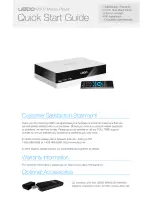
Component Overview
Chapter 3
Using the VTR API
Component Overview
If you want to control a tape deck programmatically while not actively encoding,
the Vela Software Developer’s Kit provides a stand-alone VTR component that
uses Sony 9-pin protocol to communicate through a serial port with a tape deck.
(References on the 9-pin protocol are available on the Internet or can be ordered
from Sony.) This particular COM component is called VTR.dll. Its type library,
VTR.tlb, is inserted in the
C:\ Program Files \ Vela Research \ Argus \ SDK
\ TypeLibs
folder when the SDK is installed. The customer interface provided for
the VTR component is IVTRCenter.
Note that VTR.dll should not be confused with VTRControl.dll, a component of the
Argus encoder software architecture that is directly managed by Filter Manager. If
the “Source Enabled” key in the “VTR” Windows Registry is set to 1, VTRCon-
trol.dll is responsible for controlling the VTR during the encoding process, starting
with the cue phase of the encode. Minimally, if the “Source Enabled” key is set to 0,
VTRControl.dll is responsible for logging and managing the duration of the encode.
On the other hand, the VTR component is an “extra.” You can successfully run the
encoder without using it. Though it is not required, the VTR component provides
you with a set of methods to control the tape deck
between
encodes. For example,
you can use it to tell the tape deck to fast-forward, rewind, jog, or shuttle. Or, in
preparation for setting your mark-in or mark-out value, you can instruct the VTR
component to retrieve the current time code from the tape deck. Alternatively, you
could substitute your own VTR-control software or a third-party package.
The center panel of “FMTestApp,” the C++ sample encoder application, offers a
set of buttons and edit fields that illustrate the use of a few of the methods of the
VTR component. Also included with the Software Developer’s Kit is “VTR-
TestApp,” an application that more comprehensively illustrates the use of the
methods exposed through the VTR COM component. Source code is provided.
If the Filter Manager component already has control of the serial port used to con-
trol the tape deck, the commands issued by the VTR component will not work.
Therefore, the Filter Manager component exposes a
VTRDisconnect()
method.
The Filter Manager
VTRDisconnect()
method allows you to detach from the serial
port before giving control of the port to the VTR component. Likewise, the Filter
Manager
VTRConnect()
method can be used to return control of the serial port to
the Filter Manager component prior to an encode. Of course, these two Filter
Manager methods are meaningful and effective only when the “VTR” Windows
















































